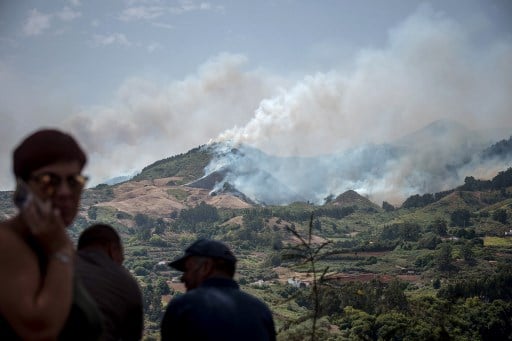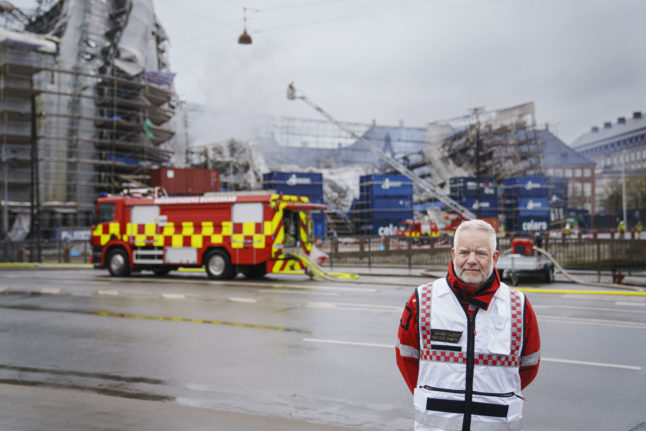The fire is the third in 10 days in the mountainous centre of the holiday island popular for its lush interior and breathtaking views.
When did the fire start?
The fire broke out on Saturday afternoon in a ravine in the municipality of the aptly named, Valleseco (Dry Valley) and spread quickly.
Where is it?
The fire has ripped through the Tamadaba Natural Park on the northwest interior of the island.
.jpg)
.jpg)
Smoke from the blaze was visible across the island and the blaze was even visible from the neighbouring island of Tenerife.
#IFValleseco #IFGranCanaria Que pena. Visto desde Tenerife pic.twitter.com/HJ5Sdb8S0u
— Javier (@watiotenerife) August 19, 2019
Evacuations
The blaze has forced the evacuation of several villages, which according to the census have a combined population of 9,000, a spokeswoman for emergency services said.
An estimated 400 people took refuge overnight in six temporary shelters set up in Mateo, Teror, Gáldar, Moya, Agaete and Tunte.
Around 100 people had been “confined” to the cultural centre of Artenara, unable to leave this village in the disaster zone.
Authorities reported that a group of people, numbered to be around 100, were holed up inside a cultural centre in Artrnara as flames approached and had been advised to stay where they were until it was deemed safe enough to evacuate. At present they are trapped in the disaster zone as all possible evacuation roads were too dangerous to take.
The municipalities that have been affected include the entire urban zone of Valleseco, the neighbourhood of El Carrizal de Tejeda, and the neighbourhoods of El Valle and El Risco, in Algaete.
Residents of the villages of Saucillo in Gáldar and Piletas and Troya in Agaete have also been moved to safer ground.
What’s the damage?
El infierno en Gran Canaria. Sin palabras a como se juegan la vida esta gente. pic.twitter.com/rznBrZ3Q35
— laspalmas69 (@albertrotsky69) August 18, 2019
Authorities estimate that around 6,000 hectares have already been destroyed. Part of the ravaged area is within a UNESCO biosphere reserve and includes the Tamadaba pine forest, celebrated as one of the “great green jewels of Gran Canaria”.
It is the third fire to break out within ten days.
Gran Canaria cumple 10 días con incendios:
10 agosto…#IFArtenara,1.163 ha
13 agosto…#IFCazadores, 160ha
17 agosto…#IFValleseco, 8.000 evacuados, 6.000ha y sigue activo pic.twitter.com/XYLMxzZSxp— Cabildo Gran Canaria (@GranCanariaCab) August 19, 2019
The fire is also threatening the Inagua reserve, an area of huge biodiversity that is the most protected zone of the island.
The wildfires were described as causing “enviromental damage without precendent on the island”.
“We are talking about the distruction of tens of thousands of plants endemic to the Canary Islands, and about 60 plant species that are exclusively found on Gran Canaria,” explained Juli Caujapé, director of the botanical garden “Viera y Clavijo”, a conservation center on the island.
No fatalities have yet been reported.
Angel Victor Torres, president of the Canary Islands, said Sunday the priority was “to guarantee the safety of people given that the environmental damage has already been caused.”
“We want this to end without human casualties.”
Road closures:
By Monday afternoon, 21 roads had been closed in the northwestern corner of the island.
#IFGranCanaria 21 carreteras permanecen cortadas por el incendio. Las labores de extinción se centran en impedir que el fuego avance y no se puede garantizar la seguridad para los conductores @GranCanariaCab @CarreterasGC pic.twitter.com/3Z8kNs1PnU
— RTVC (@RTVCes) August 19, 2019
Here is a list of the current road closures:
#IFValleseco #IFGranCanaria
Actualización 11.25 h. pic.twitter.com/sF5PAe20Bc— Carreteras GC (@CarreterasGC) August 19, 2019
What is being done to stop it?
Authorities have admitted that the fire is so fierce that is currently unstoppable.
“It's beyond our extinction capacities,” Federico Grillo, head of emergency services in Gran Canaria, said late Sunday.
“It's a really bad situation,” he said.
On the northwestern flank of the blaze, flames have risen as high as 50 metres (160 feet), preventing ground crew from getting near or water-dropping aircraft from flying above, the emergency services spokeswoman said.
Spain has flown military transport planes to Gran Canaria to send soldiers to help fight the blaze.
Cuatro aviones #Apagafuegos operados por el #43Grupo y otros cuatro #helicópteros #SúperPuma @AirbusHeli del #82Grupo #SAR del #Ala46 #Canarias están a disposición de la lucha contra el #IFGranCanaria #IFValleseco #IFArtenara #IFTejeda #ApagaYVamonos @UMEgob @mapagob pic.twitter.com/xfW9bwF9q8
— Ejército del Aire (@EjercitoAire) August 19, 2019
Altogether, more than 700 firefighters and other ground crew and 14 water-dropping helicopters and planes were working on controlling the blaze, which has destroyed 6,000 hectares, according to emergency services.
With the temperature set to rise, authorities estimate it could take days before the blaze is brought under control.
Spain's Minister of Agriculture, Luis Planas flew into the island on Monday morning to meet with local authorities at the Security Coordination Centre in the island's capital Las Palmas.
El ministro en funciones @LuisPlanas explica que su presencia en #GranCanaria es para mostrar la solidaridad y el apoyo del Gobierno de España a #Canarias y que tiene a su disposición, en estas horas difíciles, todos los medios para luchar contra #IIFF#IFValleseco #IFGranCanaria pic.twitter.com/Ut5xilDOGg
— Ministerio de Agricultura, Pesca y Alimentación (@mapagob) August 19, 2019
Will your holiday be affected?
The fire is raging in the interior of the island while most of the Gran Canaria’s visitors stick to the coastal areas and the beach resorts.
The interior does attract the more intrepid visitor though, and is popular with hikers.
In a statement, the government of the Canary Islands said the tourism industry on the island remained unaffected “given that the fire is confined to upland parts,” with no resorts impacted and no flight delays.
Indignation
Some pointed out the lack of media coverage of the fires – which failed to make front page headlines in Spanish newspapers on Monday morning – comparing it to the headlines when Notre Dame in Paris was destroyed by fire.
La prensa cuando arde Notre Dame vs. La prensa cuando un incendio quema 6.000 hectáreas y desaloja a 8.000 personas. Va a ser cierto eso de que Canarias solo importa a la hora de irse de vacaciones #IFGranCanaria pic.twitter.com/elA68OrieR
— Leticia (@_letiperez) August 19, 2019



 Please whitelist us to continue reading.
Please whitelist us to continue reading.
Member comments